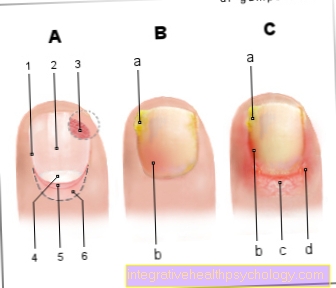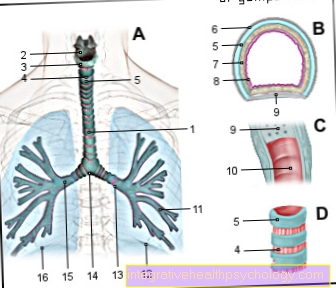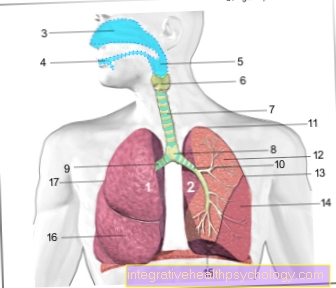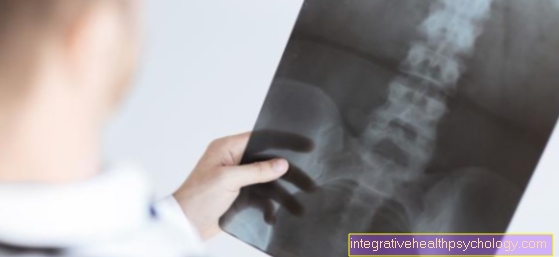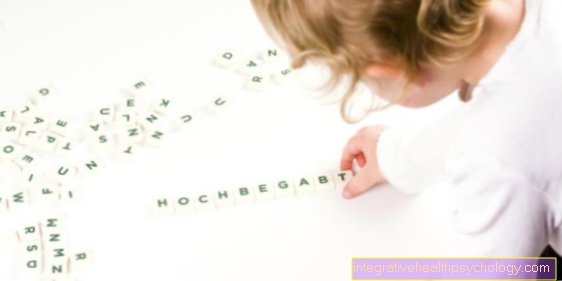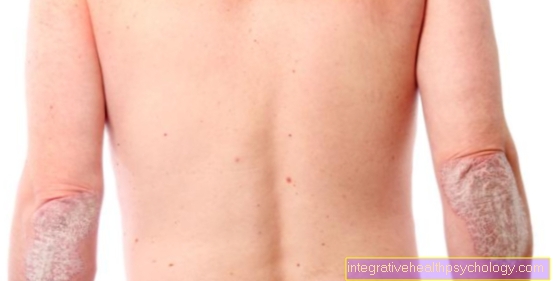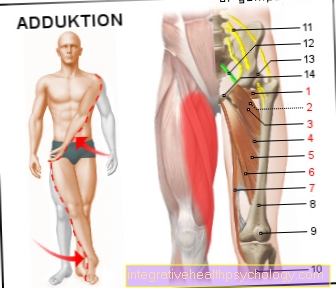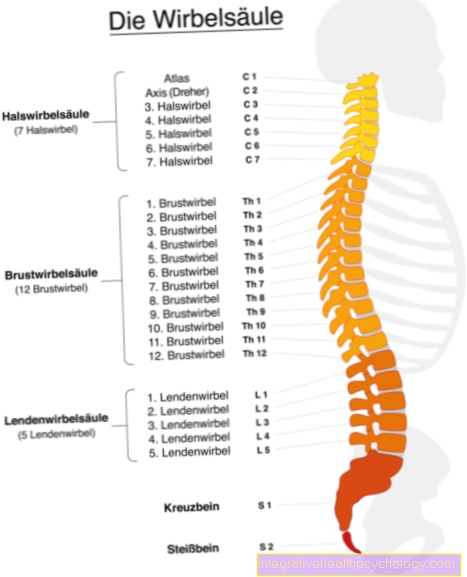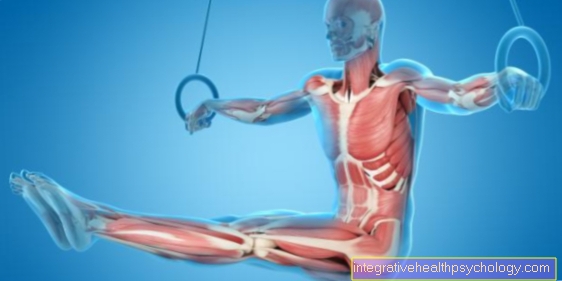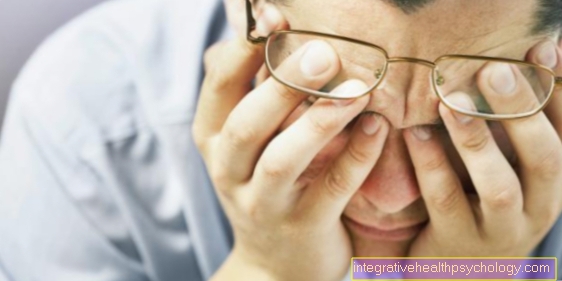Cracking sternum
definition
Cracking on the sternum is the name given to noises that emanate from the joints between the sternum and the two collarbones or the connections to the ribs. The tones can occur, for example, when stretching the upper body or changing position such as standing up from a sitting position. The cracking does not always produce an audible noise, but sometimes this is only felt by the person concerned. Cracking on the sternum is generally harmless and does not indicate a serious illness. It may be related to tension, which in turn can lead to pain and restricted mobility.

causes
As the central bone of the front rib cage, the sternum is connected to the ribs via many small joints and to the shoulders and arms via the collarbones. It is in motion with every breath and every turn. Because of these many connections and mobility, the sternum cracks often, which can have various causes. In most cases, however, it ultimately remains unclear what exactly is responsible for the cracking.
Most of those affected have no further complaints and the cracking of the sternum is without any disease value. In some cases, the cause of the noises can be assumed to be poor posture or improper exercise. People who sit a lot and support their elbows, for example, often suffer from muscular tension. In addition to other complaints, it can also trigger a cracking sternum. This can be explained by the fact that the tense muscle fibers exert tension on the individual bone elements. If you change the body position or stretch the upper body, the ribs or collarbones jump back into their correct position, which is then perceived as a crack in the sternum. How exactly such noises originate in joints has not been proven with certainty. Another explanation is that in the small joints between the bones, bubbles of nitrogen accumulate, which burst when you move and thus trigger the cracking.
Cracking sternum after a heart operation
As part of an open operation on the heart, the sternum is usually sawed open lengthways so that the chest can be opened to the side and access to the organ is made possible. After completing the operation on the heart, the two halves of the sternum are put back together and fixed with wires or clamps. The wires ensure the stability of the bone until it has grown back together again after about six weeks. During this time there is still a slightly increased mobility of the sternum when breathing and moving. For this reason, the sternum cracks more often during the healing phase after a heart operation. However, this is completely harmless, even if it is very loud, as long as no further symptoms such as severe pain or shortness of breath occur.
Concomitant symptoms
In most cases, a crack in the sternum is not accompanied by any symptoms. You may feel that the cracking has released a joint blockage or you have the feeling that a rib or collarbone has slipped back into the correct position.
If there is muscular tension, for example in the context of a cervical spine syndrome, the accompanying symptom may be pain in the sternum or neck or back pain.
If the crack in the sternum was preceded by an accident, for example during sports or in traffic, a bruise mark or a bruise on the skin can be an accompanying symptom. In such a case, a doctor should be consulted to rule out the possibility of a bony injury.
A medical examination is also advisable if the accompanying symptom is severe, movement-independent pain in the chest area or shortness of breath. Even if the cracking in the sternum itself is almost always harmless, these symptoms can be an indication of an additional disease of internal organs such as the heart or lungs.
Appointment with a back specialist?

I would be happy to advise you!
Who am I?
My name is dr. Nicolas Gumpert. I am a specialist in orthopedics and the founder of .
Various television programs and print media report regularly about my work. On HR television you can see me every 6 weeks live on "Hallo Hessen".
But now enough is indicated ;-)
The spine is difficult to treat. On the one hand it is exposed to high mechanical loads, on the other hand it has great mobility.
The treatment of the spine (e.g. herniated disc, facet syndrome, foramen stenosis, etc.) therefore requires a lot of experience.
I focus on a wide variety of diseases of the spine.
The aim of any treatment is treatment without surgery.
Which therapy achieves the best results in the long term can only be determined after looking at all of the information (Examination, X-ray, ultrasound, MRI, etc.) be assessed.
You can find me in:
- Lumedis - your orthopedic surgeon
Kaiserstrasse 14
60311 Frankfurt am Main
Directly to the online appointment arrangement
Unfortunately, it is currently only possible to make an appointment with private health insurers. I hope for your understanding!
Further information about myself can be found at Dr. Nicolas Gumpert
Difficulty breathing
Difficulty breathing can have many different causes and also occur at the same time as a cracking sternum. It is possible that there is a common cause, such as muscle tension. This can impair breathing and also be responsible for the crackling. However, it is also possible that both symptoms are independent of one another and only happened to be noticed at the same time. The cracking of the sternum is harmless and does not indicate a threatening disease.
Difficulty breathing, on the other hand, can have a variety of possible causes, in some cases a serious illness that requires treatment. Breathing difficulties without an apparent cause should therefore be clarified by a medical examination. In the event of a sudden onset of breathlessness, it may even be possible to notify the emergency services.
diagnosis
In the case of a cracking of the sternum that goes hand in hand with no further symptoms, no diagnosis is usually made at all, as it is a natural sound emanating from the body that is without any disease value. In order to investigate the suspicion of whether muscular tension may be partly responsible for the cracking, the doctor may ask whether the patient suffers from pain in the chest area when moving. A short physical examination, in which the doctor pays attention to incorrect posture, asymmetries or a restriction in mobility, is at best possible.
Measures going beyond this, such as imaging using X-rays, are not appropriate if the sternum cracks and should be avoided due to unnecessary radiation exposure.
therapy
Since sternum cracking is completely normal and has no disease value, no treatment is required as long as it is the only symptom.
If the patient also suffers from muscular tension and symptoms such as pain and restricted mobility, therapy should be given to alleviate or eliminate these symptoms over the long term. The aim is to improve posture and stabilize the trunk. The most important measure is movement so that the muscles are strengthened and the joints remain flexible. Suitable sports are, for example, swimming, cycling or Nordic walking. Regular walks are also valuable, especially when they are seated, in order to enable a physical balance. A back school for several weeks to specifically strengthen the back muscles is also recommended in many cases, although the costs are mostly covered by the health insurance company.
If the muscular tension causes severe pain in addition to a crack in the sternum, which hinders physical activity, a short-term use of a pain reliever may be indicated.
Duration
The cracking of the sternum usually occurs at irregular intervals during movement such as stretching after getting out of bed and then only lasts for a fraction of a second. For some people, certain movements can provoke the noise repeatedly. The cracking can be louder and more intense on some days and absent on others. Often it accompanies the person affected for a lifetime without any consequences. If, on the other hand, an acute trigger is related to the cracking of the sternum, such as muscular tension, the duration often corresponds to the time over which the tension exists. If the sternum cracks repeatedly for a long time without any further symptoms, this is completely harmless and no reason to consult a doctor.



